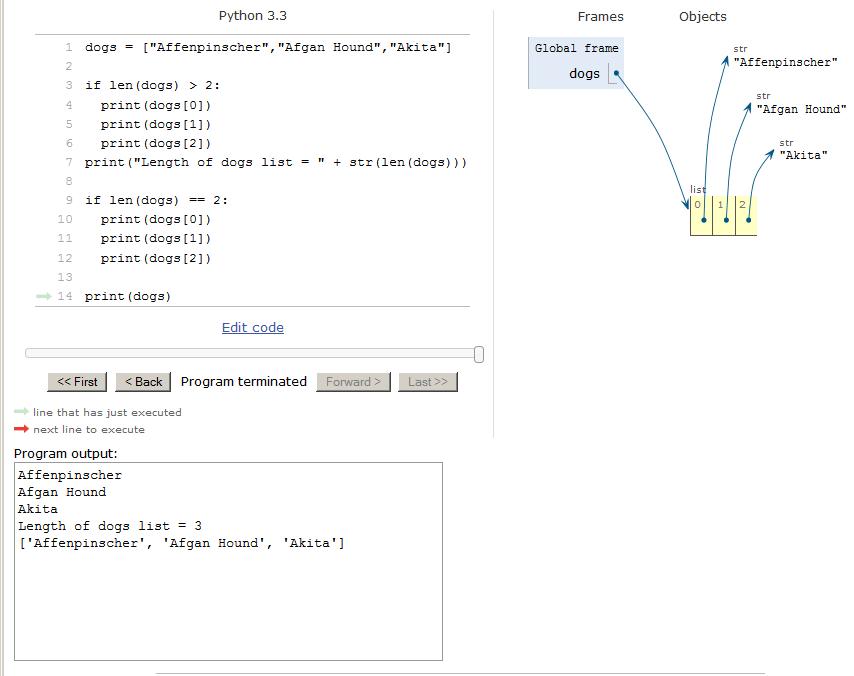| << Chapter < Page | Chapter >> Page > |
The output from the code in Listing 1 is shown in Figure 2 .
| Figure 2 . Output from the code in Listing 1. |
|---|
Affenpinscher
Afgan HoundAkita
Length of dogs list = 3['Affenpinscher', 'Afgan Hound', 'Akita'] |
Listing 1 begins by creating and populating a list containing the names of three breeds of dogs. Then it tests to see if the length of the list isgreater than 2, which it is.
Because the test returns True, each element in the list is printed in sequence by the three indented print statements.
After that, the length of the list is printed by the non-indented print statement. This requires that the numeric length of the list be obtained and converted to a string for printing.
The built-in function named len is called here (and also in the conditional clause of the if statement) to get the length of the list.
The built-in function named str is called to convert the numeric length of the list into a string for concatenationwith another string for printing.
Then the process is repeated except instead of testing the length of the list for greater than 2 , it is tested for equal to 2 . This test returns False, which causes the indented print statements in the body of the if statement to be skipped.
After that, the list is printed producing the last line of text in Figure 2 .
Figure 3 shows a visualization of the code in Listing 1 . I recommend that you create this visualization on your own and step through theprogram one instruction at a time. As you do that, pay attention to the movements of the red and green arrows on the left, the diagram on the right, andthe printed material at the bottom. That should help you to better understand the behavior of an if statement.
Figure 3. Visualization of the code in Listing 1.

The next section will use a function named randint belonging to a module named random . Therefore, I need to say a few words about modules at this point. I will discuss modules in more detail in a futuremodule.
You learned about creating scripts in the earlier module titled Itse1359-1050-Introduction to Scripts . If you save a script in a file, you can import it into another script and use it later. When used in this way, a file containing a script is called a module .
The previous section touched on the fact that Python has a number of built-in functions such as len and str . Similarly, the standard Python distribution includes The Python Standard Library that includes a large number of pre-written modules. One of those modules is named random . The purpose of the random module is to generate pseudo-random numbers. The random module provides many functions, one of which is named randint(a,b) This function will return a random integer with a value between a and b inclusive.
All that is necessary to use a built-in function such as len or str is to call out its name as shown in Listing 1 . I interpret this to mean that the built-in functions occupy memory any time that the Pythoninterpreter has been loaded into memory (but I may be wrong on that) .

Notification Switch
Would you like to follow the 'Itse 1359 introduction to scripting languages: python' conversation and receive update notifications?